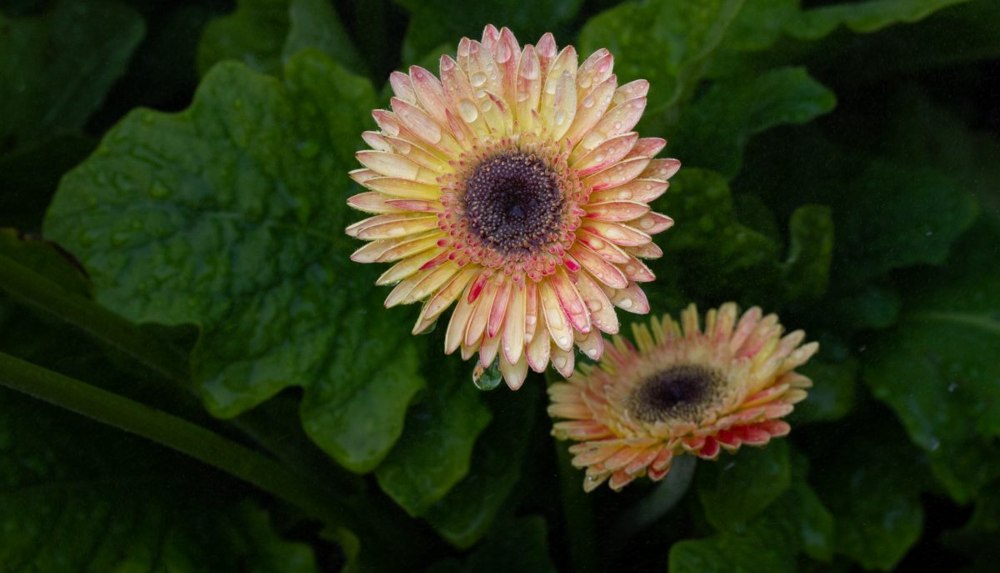
We have had a rather dark and stormy autumn here; a good deal of the autumn color has been torn from the trees by our fierce winds, earlier than usual I think. Our moments of being transfixed by the show are unpredictable: I roll into my driveway and a late-blooming dahlia catches my attention, glowing luminescent pink with a soft yellow center. Where has she been all summer, when her gaudy scheme would, perhaps, have gone unnoticed?

Now I see her, and she opens for me the insight that pink, of all things, is intrinsic to autumn. I see it everywhere, shining through the edges of orange, coloring the small leaves of sedum which were red-brown the last time I looked, and tinting the edges of lettuces in the garden. I try to keep my eyes wide open for other shocking moments: wow! a brilliant deep yellow Big Leaf Maple jumps out of her evergreen fir alcove as I glide by at 40 mph. These are among the joys of the season.
Life in the garden this time of year is contrary. There are the many small observations of life retreating underground to roots and our own retreating with them. Then there are the many chores of raking, cutting back, and clearing the abundance of fallen and rotting vegetation. In nature, of course, this all goes back to the soil, organic matter to replenish nutrients and tilth.
Since we are basically interfering with nature to meet our own needs, we want and need to do this tidying-up, but the material should go in your compost pile, if you keep one, or you can haul it all to the dump, pay to dispose of it and pay to buy it back in the form of finished compost. This is good stuff, certified, you can ask for the report! Or you can buy manure, cover crops, or compost from other sources and apply a layer for the winter rains to melt into your beds to be ready for spring.
The gardening I do this time of year is all dedicated to the future. It’s a great time to plant or transplant because the soil is still warm and roots will settle in just like your toes when you slip into bed with an extra blanket. This is particularly so here in the gentle rainshadow where I live in Port Townsend, and deep frost comes late, if at all. It’s the perfect moment to be settling in the bulbs – a chore – but the only way to have those surprising little blooms greeting us in late winter and on in to May.
Its also a great time to lollygag and just look – what is crowded, what needs to come out completely, however sad you are to see it go – this is your job as the gardener. You are preparing for renewal, for the place you want your garden to be next year. Time to lay down cardboard and mulch to smother grass and weeds for a new planting area – let rain and time do the work.
All the thoughts and feelings you have while doing these chores are what the garden offers us year-round: to be enfolded in the drama of the natural seasons as they exist, also, in our lives. A bit of melancholy? A bit of welcome rest? A folding in and turning to inner lives, reading, other interests, that have taken a backseat to the quest to accomplish, grow, harvest and store from spring through summer?
Of course, the seasonality of place changes greatly with longitude and latitude, mountains, winds and oceans. Our rainshadow and the PNW modify extremes well known in other places. We have gentle transitions. Our cycle more dominated by the light than the frost or snow, we exhaust ourselves in the go-go of the eighteen hours of high summer daylight and we hibernate like wise animals in the six hours of daylight allowed us at the Winter Solstice, coinciding nicely with our holiday season when we can distract ourselves with eating and drinking and material pleasures before we head back to bed.
Then just after the solstice, around here, it is not the frozen half-death of deep-freeze winters, but rather, the beginning of spring. The plants notice immediately the extra minutes of light, stems fatten and turn red, blushes of subtle color emerge in brush and meadows. We begin the slow march into what must be the world’s longest spring, from Christmas to the Fourth of July – another season for another essay.
By the way, my love of seasonality is so great I have had to restrain myself, through this whole piece, from capitalizing Spring, Summer, Fall and Winter. They are the markers of our time on earth.
